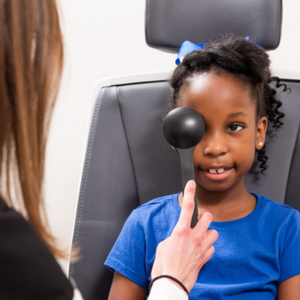 Being unable to see well in school is not only a scary thought for us and our kids, but it also has serious academic consequences. According to a recent study published by JAMA Ophthalmology entitled, “Effect of a Randomized Interventional School-Based Vision Program on Academic Performance of Students in Grades Three to Seven,” students who received eye exams and were prescribed corrective lenses scored higher on standardized tests in reading and math.
Being unable to see well in school is not only a scary thought for us and our kids, but it also has serious academic consequences. According to a recent study published by JAMA Ophthalmology entitled, “Effect of a Randomized Interventional School-Based Vision Program on Academic Performance of Students in Grades Three to Seven,” students who received eye exams and were prescribed corrective lenses scored higher on standardized tests in reading and math.
The study also reported that students who received glasses gained an equivalent of almost four months of extra education. Yes. You read that correctly. This study shows just a couple of the many important reasons to take your children to get eye exams.
Elise Agostinelli, OD, pediatric optometrist with UAB Callahan Eye had a patient who came in for an eye exam after being referred by her pediatrician for failing a vision screening. She was six years old and just started kindergarten. Her mom expressed concerns that she was falling behind in school and not interested in any of her schoolwork. Dr. Agostinelli discovered in the exam that the patient was extremely nearsighted. She showed her patient what her new glasses prescription would look like, and her face lit up. She gave the biggest smile to her mom and said, “I can see now!” Her mom was ecstatic when they returned six weeks later for her follow-up visit and stated her daughter was excited about going to school now and had found a love for reading!
The First Pediatric Eye Exam
According to Dr. Agostinelli, the most important thing we can tell our children before their first eye exam is that it will not involve shots! We should also tell them that their eye doctor will make the exam as fun as possible, so they should expect to be playing games, playing with different toys, and getting surprises at the end of the exam!
Callahan starts with patient history before taking visual acuity by either matching shapes with the patient or reading the letters on an eye chart. There will also be preliminary tests that include evaluation of color vision, eye muscle movements, depth perception, peripheral vision, and how the pupils respond to light.
The child is then dilated with eye drops that temporarily keep the child’s eyes from changing focus during further testing. After the child is dilated, the eye doctor will use a device called a retinoscope to evaluate the focusing power of the eye to see if your child needs glasses and to check the growth of the eyes. The doctor will also use a variety of microscopes and lenses to assess the health of the eye and all the surrounding tissues.
When Should We Make That First Eye Appointment?
The American Academy of Optometry recommends a child should have his or her first eye exam between six to twelve months of age, and then at least once again between three and five years of age. There are also certain signs and symptoms that increase the risk for a child needing an eye exam.
Some signs that may indicate your child needs an eye exam include:
- complaining of headaches
- becoming fatigued after reading
- squinting or closing one eye
- blinking or rubbing eyes
- poor school performance
- holding electronics very closely
- losing his place while reading
There are also some factors that place an infant, toddler, or child at a higher risk for needing an eye exam. Those include:
- a history of prematurity
- systemic health conditions that have ocular manifestations and a family history of eye disorders
- refractive error
- and strabismus (eye turns in or outwards)
But rest assured that the initial pediatric eye exam will not be scary when the professionals at UAB Callahan Eye are involved.
Thank you to the Birmingham Mom Collective for their participation in this article.